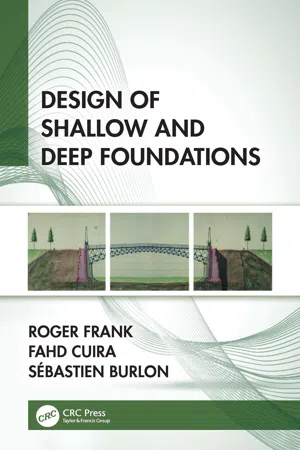
- 200 pages
- English
- ePUB (mobile friendly)
- Available on iOS & Android
Design of Shallow and Deep Foundations
About This Book
Design of Shallow and Deep Foundations introduces the concept of limit state calculations, before focusing on shallow and deep foundations. The limit state combinations of actions are examined, and practical calculation models of the bearing capacity and of the settlement are presented, particularly from the results of Ménard pressuremeter tests and cone penetration tests. Attention is also given to the use of numerical methods, which has been developed over the past twenty years. It provides an overview of various elements of ground-structure interaction that are pertinent for a refined design of both shallow and deep foundations, such as allowable displacements of structures, and ground-structure couplings.
This guide will be useful to practising engineers and experts in design offices, contracting companies and administrations, as well as students and researchers in civil engineering. Though its focus is generally on the French practice, it is more widely applicable to design based on, or generally in line with, Eurocode 7, with references to BS ENs.
Roger Frank is an Honorary Professor at Ecole Nationale des Ponts et Chaussées (ENPC). From 1998 to 2004, he chaired the committee on Eurocode 7 on Geotechnical design.
Fahd Cuira is the Scientific Director of Terrasol (Setec group), France. Since 2018, he has been in charge of the course on the design of geotechnical structures at ENPC.
Sébastien Burlon is a Project Director at Terrasol (Setec group), France. He is involved in the evolution of Eurocode 7 and teaches several geotechnical courses, especially at ENPC.
Frequently asked questions
Information
Chapter 1
1.1 Definition of actions
- “Deformations that affect the appearance, the comfort of users, the functioning of the structure (including the functioning of machines or services), or that cause damage to finishes or non-structural members;
- Vibrations that cause discomfort to people or that limit the functional effectiveness of the structure;
- Damage that is likely to adversely affect the appearance, the durability or the functioning of the structure”.
- “Loss of equilibrium of the structure or any part of it, considered as a rigid body;
- Failure by excessive deformation, transformation of the structure or any part of it into a mechanism, rupture, and loss of stability of the structure or any part of it, including supports and foundations;
- Failure caused by fatigue or other time-dependent effects”.
1.1.1 Permanent actions G
- The self-weight of the foundation;
- The self-weight of the support (pier, abutment, pile cap, etc.);
- The fraction of the self-weight of the building or of the considered structure and of its equipment carried by the foundation;
- Forces due to shrinkage, creep, etc.;
- Forces due to ground weight and ground pressure;
- Groundwater pressure applied on a retaining wall....
Table of contents
- Cover
- Half Title
- Title Page
- Copyright Page
- Table of Contents
- Preface
- Additional Preface for the English Version
- Authors
- 1 Actions for Limit State Design
- 2 Shallow Foundations
- 3 Deep Foundations
- 4 Interactions with the Supported Structure
- Bibliography